Non-Invasive Prenatal Testing: Ethics & Applications
VerifiedAdded on 2020/01/15
|14
|5929
|235
AI Summary
This assignment delves into the multifaceted aspects of non-invasive prenatal testing (NIPT), examining its applications in both screening and diagnosis. It explores the ethical considerations surrounding NIPT, including potential biases in selection against disability and the influence of societal perceptions on reproductive choices. The assignment also touches upon the legal and regulatory frameworks governing NIPT, highlighting the need for clear guidelines and informed consent practices.
Contribute Materials
Your contribution can guide someone’s learning journey. Share your
documents today.
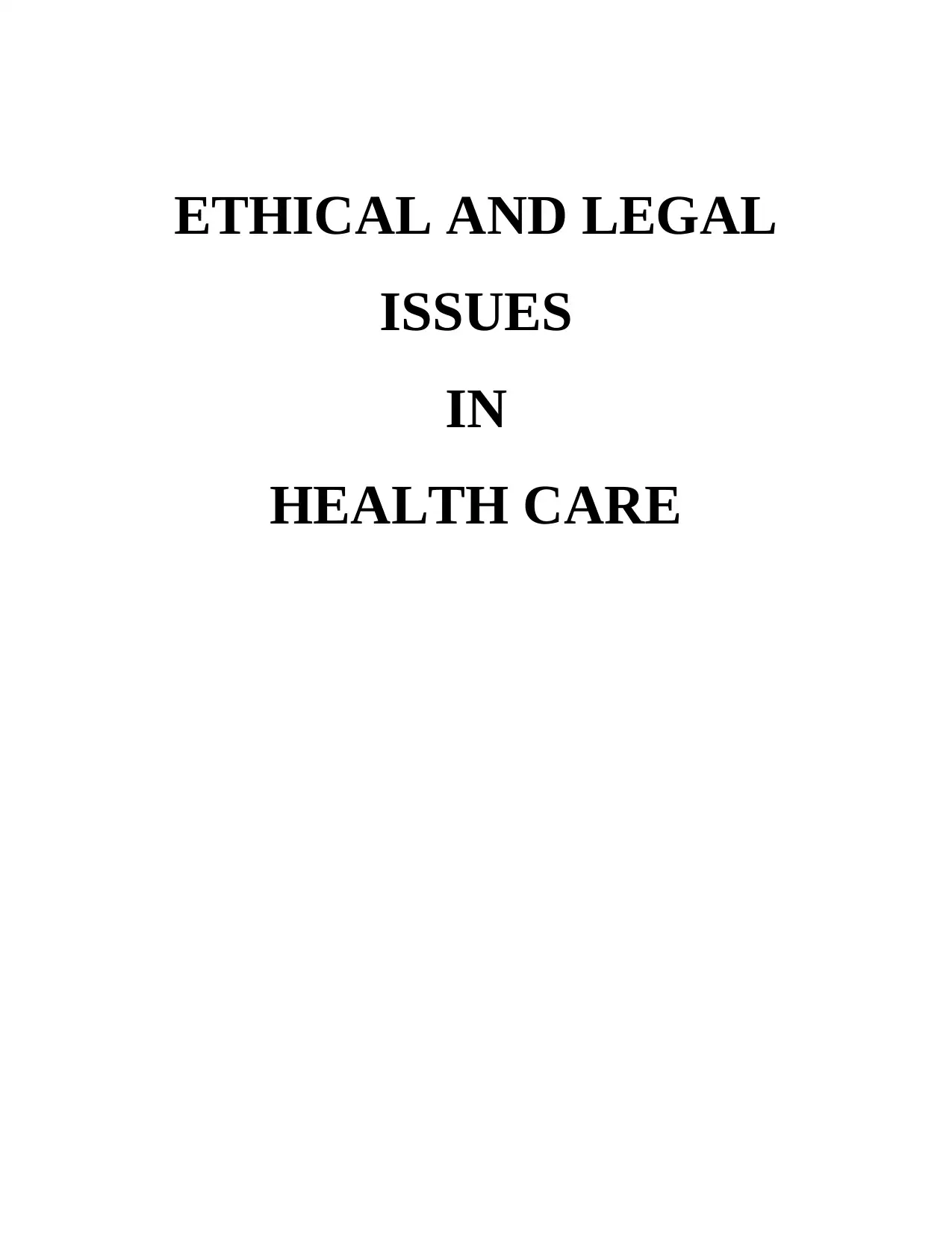
ETHICAL AND LEGAL
ISSUES
IN
HEALTH CARE
ISSUES
IN
HEALTH CARE
Secure Best Marks with AI Grader
Need help grading? Try our AI Grader for instant feedback on your assignments.
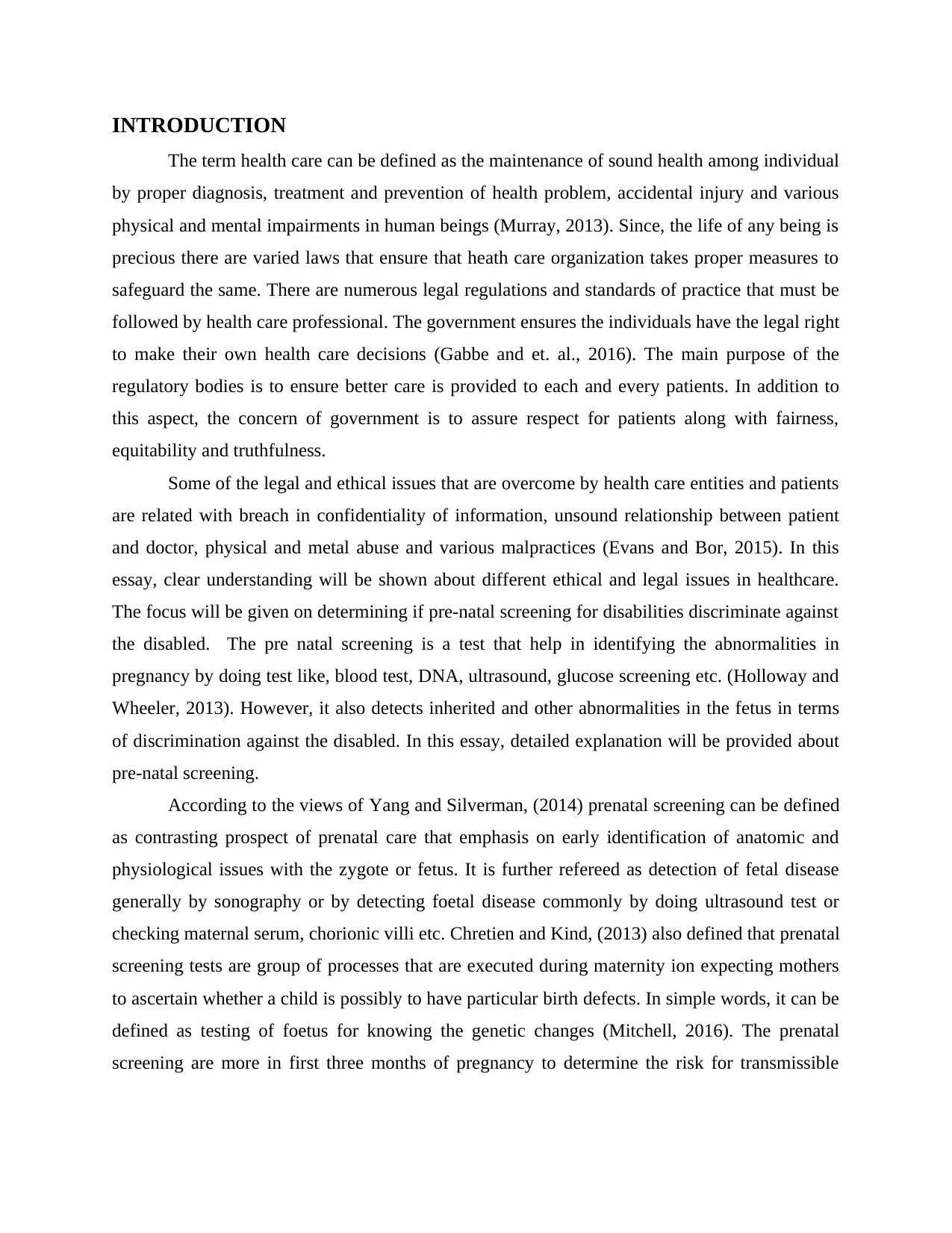
INTRODUCTION
The term health care can be defined as the maintenance of sound health among individual
by proper diagnosis, treatment and prevention of health problem, accidental injury and various
physical and mental impairments in human beings (Murray, 2013). Since, the life of any being is
precious there are varied laws that ensure that heath care organization takes proper measures to
safeguard the same. There are numerous legal regulations and standards of practice that must be
followed by health care professional. The government ensures the individuals have the legal right
to make their own health care decisions (Gabbe and et. al., 2016). The main purpose of the
regulatory bodies is to ensure better care is provided to each and every patients. In addition to
this aspect, the concern of government is to assure respect for patients along with fairness,
equitability and truthfulness.
Some of the legal and ethical issues that are overcome by health care entities and patients
are related with breach in confidentiality of information, unsound relationship between patient
and doctor, physical and metal abuse and various malpractices (Evans and Bor, 2015). In this
essay, clear understanding will be shown about different ethical and legal issues in healthcare.
The focus will be given on determining if pre-natal screening for disabilities discriminate against
the disabled. The pre natal screening is a test that help in identifying the abnormalities in
pregnancy by doing test like, blood test, DNA, ultrasound, glucose screening etc. (Holloway and
Wheeler, 2013). However, it also detects inherited and other abnormalities in the fetus in terms
of discrimination against the disabled. In this essay, detailed explanation will be provided about
pre-natal screening.
According to the views of Yang and Silverman, (2014) prenatal screening can be defined
as contrasting prospect of prenatal care that emphasis on early identification of anatomic and
physiological issues with the zygote or fetus. It is further refereed as detection of fetal disease
generally by sonography or by detecting foetal disease commonly by doing ultrasound test or
checking maternal serum, chorionic villi etc. Chretien and Kind, (2013) also defined that prenatal
screening tests are group of processes that are executed during maternity ion expecting mothers
to ascertain whether a child is possibly to have particular birth defects. In simple words, it can be
defined as testing of foetus for knowing the genetic changes (Mitchell, 2016). The prenatal
screening are more in first three months of pregnancy to determine the risk for transmissible
The term health care can be defined as the maintenance of sound health among individual
by proper diagnosis, treatment and prevention of health problem, accidental injury and various
physical and mental impairments in human beings (Murray, 2013). Since, the life of any being is
precious there are varied laws that ensure that heath care organization takes proper measures to
safeguard the same. There are numerous legal regulations and standards of practice that must be
followed by health care professional. The government ensures the individuals have the legal right
to make their own health care decisions (Gabbe and et. al., 2016). The main purpose of the
regulatory bodies is to ensure better care is provided to each and every patients. In addition to
this aspect, the concern of government is to assure respect for patients along with fairness,
equitability and truthfulness.
Some of the legal and ethical issues that are overcome by health care entities and patients
are related with breach in confidentiality of information, unsound relationship between patient
and doctor, physical and metal abuse and various malpractices (Evans and Bor, 2015). In this
essay, clear understanding will be shown about different ethical and legal issues in healthcare.
The focus will be given on determining if pre-natal screening for disabilities discriminate against
the disabled. The pre natal screening is a test that help in identifying the abnormalities in
pregnancy by doing test like, blood test, DNA, ultrasound, glucose screening etc. (Holloway and
Wheeler, 2013). However, it also detects inherited and other abnormalities in the fetus in terms
of discrimination against the disabled. In this essay, detailed explanation will be provided about
pre-natal screening.
According to the views of Yang and Silverman, (2014) prenatal screening can be defined
as contrasting prospect of prenatal care that emphasis on early identification of anatomic and
physiological issues with the zygote or fetus. It is further refereed as detection of fetal disease
generally by sonography or by detecting foetal disease commonly by doing ultrasound test or
checking maternal serum, chorionic villi etc. Chretien and Kind, (2013) also defined that prenatal
screening tests are group of processes that are executed during maternity ion expecting mothers
to ascertain whether a child is possibly to have particular birth defects. In simple words, it can be
defined as testing of foetus for knowing the genetic changes (Mitchell, 2016). The prenatal
screening are more in first three months of pregnancy to determine the risk for transmissible
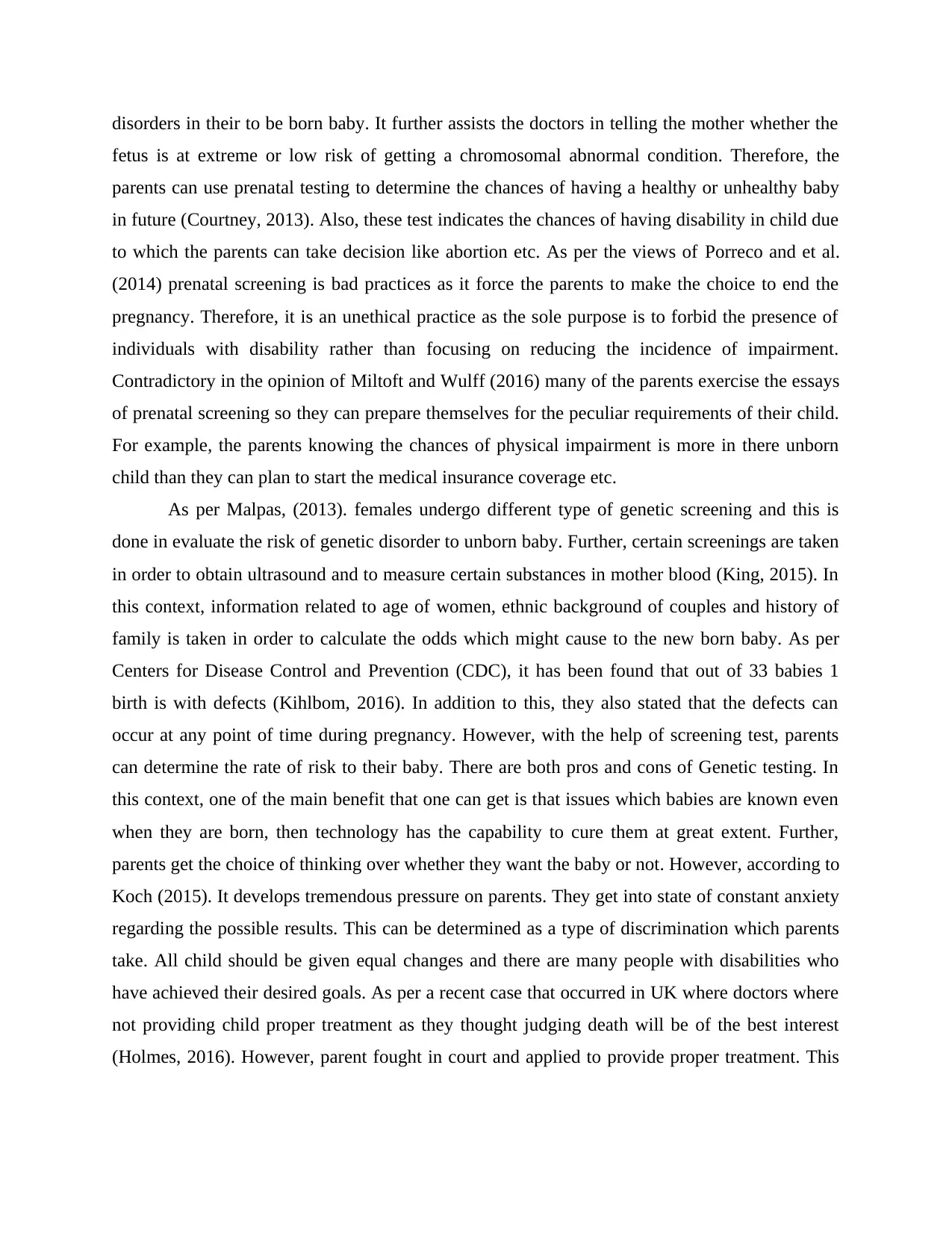
disorders in their to be born baby. It further assists the doctors in telling the mother whether the
fetus is at extreme or low risk of getting a chromosomal abnormal condition. Therefore, the
parents can use prenatal testing to determine the chances of having a healthy or unhealthy baby
in future (Courtney, 2013). Also, these test indicates the chances of having disability in child due
to which the parents can take decision like abortion etc. As per the views of Porreco and et al.
(2014) prenatal screening is bad practices as it force the parents to make the choice to end the
pregnancy. Therefore, it is an unethical practice as the sole purpose is to forbid the presence of
individuals with disability rather than focusing on reducing the incidence of impairment.
Contradictory in the opinion of Miltoft and Wulff (2016) many of the parents exercise the essays
of prenatal screening so they can prepare themselves for the peculiar requirements of their child.
For example, the parents knowing the chances of physical impairment is more in there unborn
child than they can plan to start the medical insurance coverage etc.
As per Malpas, (2013). females undergo different type of genetic screening and this is
done in evaluate the risk of genetic disorder to unborn baby. Further, certain screenings are taken
in order to obtain ultrasound and to measure certain substances in mother blood (King, 2015). In
this context, information related to age of women, ethnic background of couples and history of
family is taken in order to calculate the odds which might cause to the new born baby. As per
Centers for Disease Control and Prevention (CDC), it has been found that out of 33 babies 1
birth is with defects (Kihlbom, 2016). In addition to this, they also stated that the defects can
occur at any point of time during pregnancy. However, with the help of screening test, parents
can determine the rate of risk to their baby. There are both pros and cons of Genetic testing. In
this context, one of the main benefit that one can get is that issues which babies are known even
when they are born, then technology has the capability to cure them at great extent. Further,
parents get the choice of thinking over whether they want the baby or not. However, according to
Koch (2015). It develops tremendous pressure on parents. They get into state of constant anxiety
regarding the possible results. This can be determined as a type of discrimination which parents
take. All child should be given equal changes and there are many people with disabilities who
have achieved their desired goals. As per a recent case that occurred in UK where doctors where
not providing child proper treatment as they thought judging death will be of the best interest
(Holmes, 2016). However, parent fought in court and applied to provide proper treatment. This
fetus is at extreme or low risk of getting a chromosomal abnormal condition. Therefore, the
parents can use prenatal testing to determine the chances of having a healthy or unhealthy baby
in future (Courtney, 2013). Also, these test indicates the chances of having disability in child due
to which the parents can take decision like abortion etc. As per the views of Porreco and et al.
(2014) prenatal screening is bad practices as it force the parents to make the choice to end the
pregnancy. Therefore, it is an unethical practice as the sole purpose is to forbid the presence of
individuals with disability rather than focusing on reducing the incidence of impairment.
Contradictory in the opinion of Miltoft and Wulff (2016) many of the parents exercise the essays
of prenatal screening so they can prepare themselves for the peculiar requirements of their child.
For example, the parents knowing the chances of physical impairment is more in there unborn
child than they can plan to start the medical insurance coverage etc.
As per Malpas, (2013). females undergo different type of genetic screening and this is
done in evaluate the risk of genetic disorder to unborn baby. Further, certain screenings are taken
in order to obtain ultrasound and to measure certain substances in mother blood (King, 2015). In
this context, information related to age of women, ethnic background of couples and history of
family is taken in order to calculate the odds which might cause to the new born baby. As per
Centers for Disease Control and Prevention (CDC), it has been found that out of 33 babies 1
birth is with defects (Kihlbom, 2016). In addition to this, they also stated that the defects can
occur at any point of time during pregnancy. However, with the help of screening test, parents
can determine the rate of risk to their baby. There are both pros and cons of Genetic testing. In
this context, one of the main benefit that one can get is that issues which babies are known even
when they are born, then technology has the capability to cure them at great extent. Further,
parents get the choice of thinking over whether they want the baby or not. However, according to
Koch (2015). It develops tremendous pressure on parents. They get into state of constant anxiety
regarding the possible results. This can be determined as a type of discrimination which parents
take. All child should be given equal changes and there are many people with disabilities who
have achieved their desired goals. As per a recent case that occurred in UK where doctors where
not providing child proper treatment as they thought judging death will be of the best interest
(Holmes, 2016). However, parent fought in court and applied to provide proper treatment. This

type of situation that can be avoided through screening. As stated above, in most of the cases,
there are chances that issues of disability can be solved. However, when there are no changes of
cure, then parent should take the risk that they still want to give birth to child or not, Bayefsky
and Jennings (2015). stated that in most condition the mental stage of parent is to grow up their
baby even if it has disabilities. However, in serious conditions doctors have to make decision to
abbot the child. This highly affects the mental condition and stability of parents. Further, when
screening is done and when they are provided with the information that the child is at risk and
they can be solved or any other type of situation occurs. Parents make themselves get ready to
face the same and this can be stated as one of the main advantage of screening (Evans and Bor,
2015).
Legal concept can be determined as an autonomy that serves as protecting individuals
from bodily integrity. It is the right of adults to decide whether to undergo medical interventions
or not. However, it is essential to provide all the relevant information regarding that might affect
decision making (Christenhusz and Dierickx, 2014). In this context, it includes information like
risk, benefits, nature of condition, etc. In such situations, health care providers will be held liable
if they do not provide patients with proper information. With this respect, prenatal genetic testing
enables parents to get information related with the development of fetus and in situations when
healthcare providers identify abnormal defects. As a result, it enables to prevent future child
issues and this is done by terminating pregnancy (Christenhusz and Dierickx, 2014). There are
many positive impacts due to terminations and prenatal testing as it reduces incidents related to
population of suffering because of disabling conditions. In addition to this, it also saves resources
that are needed to treat, support or compensate individual who live with disabilities.
Ethical issues in pre-natal screening for disabilities that discriminate against the disabled
Ethics can be determined as values, standards and principles of conduct. Further de Jong
and et al. (2014) also stated that results of prenatal testing only shows the probability of having
unhealthy child while there are chances that results may not be true. The essays also states that,
there are many cases when child aborted based on screening results were perfectly healthy. This
results into serious crime of killing a child with no rationale. It is also argued that prenatal test
are just for detection and are not diagnostic (Li, Chandrasekharan and Allyse, 2016). It is major
ethical issues as healthy babies are terminated due to the results of prenatal test. Therefore, the
there are chances that issues of disability can be solved. However, when there are no changes of
cure, then parent should take the risk that they still want to give birth to child or not, Bayefsky
and Jennings (2015). stated that in most condition the mental stage of parent is to grow up their
baby even if it has disabilities. However, in serious conditions doctors have to make decision to
abbot the child. This highly affects the mental condition and stability of parents. Further, when
screening is done and when they are provided with the information that the child is at risk and
they can be solved or any other type of situation occurs. Parents make themselves get ready to
face the same and this can be stated as one of the main advantage of screening (Evans and Bor,
2015).
Legal concept can be determined as an autonomy that serves as protecting individuals
from bodily integrity. It is the right of adults to decide whether to undergo medical interventions
or not. However, it is essential to provide all the relevant information regarding that might affect
decision making (Christenhusz and Dierickx, 2014). In this context, it includes information like
risk, benefits, nature of condition, etc. In such situations, health care providers will be held liable
if they do not provide patients with proper information. With this respect, prenatal genetic testing
enables parents to get information related with the development of fetus and in situations when
healthcare providers identify abnormal defects. As a result, it enables to prevent future child
issues and this is done by terminating pregnancy (Christenhusz and Dierickx, 2014). There are
many positive impacts due to terminations and prenatal testing as it reduces incidents related to
population of suffering because of disabling conditions. In addition to this, it also saves resources
that are needed to treat, support or compensate individual who live with disabilities.
Ethical issues in pre-natal screening for disabilities that discriminate against the disabled
Ethics can be determined as values, standards and principles of conduct. Further de Jong
and et al. (2014) also stated that results of prenatal testing only shows the probability of having
unhealthy child while there are chances that results may not be true. The essays also states that,
there are many cases when child aborted based on screening results were perfectly healthy. This
results into serious crime of killing a child with no rationale. It is also argued that prenatal test
are just for detection and are not diagnostic (Li, Chandrasekharan and Allyse, 2016). It is major
ethical issues as healthy babies are terminated due to the results of prenatal test. Therefore, the
Secure Best Marks with AI Grader
Need help grading? Try our AI Grader for instant feedback on your assignments.

screening provoke the prospective parents from having a disabled child. Wilson and Singletary
(2013) also states that exercise of prenatal screening done for purpose of knowing disability in
child is objectionable as it is unfair towards the individuals presently living with physical or
mental impairment. Also, the practice of prenatal screening hurt the sentiments of disabled
people. Therefore, this screening is unfair as it minimizes diversity in human (Willis and et al.,
2015). The prenatal screening is considered discriminating practice against disabled child as it
increase the efforts to preclude the existence of having disabled people in the society. This
further states that it is wrong to have disabled people in the world and they are burden which is
not true. Norton, Jelliffe-Pawlowski and Currier (2014) also states that prenatal testing is not
justified as it is silent comment on disabled people that through advance healthcare techniques
practitioners are trying to prevent the presence of other individuals like them (Chretien and Kind,
2013).
In the view of de Jong and et al. (2014) the practices of prenatal screening and choice are
not only prejudicial to the handicapped as a unit but can also be baneful to respective disabled
people in different manner. They may, for instance, strengthen or appear to legalize kind of
discrimination against present handicapped group van Schendel, Kleinveld and Henneman,
(2014) also agrees that due to prenatal screening if proved effective, they also cut down the
figure of disabled masses, thereby making each unfit individual a little more odd and also
increase their chance of being isolated from fit people. Overall, the prenatal screening is an
unfair practice that leads to the decrease in numbers of disabled people (Kihlbom, 2016). In
addition to this, it may also reduce the legal power of impaired people by diminishing their
visibility or existence.
It is general tendency that parents to think that how their baby will look like. Pre-natal
test provides parents opportunity to know all the issues that can be faced by child (Dondorp, W.
J. and et.al., 2015). As per ethical consideration, it is the responsibility of doctors to make sure
that they provide or offer prenatal screening to those who have some genetic conditions during
pregnancy. Factors that should be considered by healthcare providers include regardless for age,
health conditions, genetic disorders, etc. (Dondorp, Page‐Christiaens and Wert, 2015). There are
mainly two different choices that parents get while conducing a prenatal test and that are the
option to abort or continue pregnancy. It is important that corrective measures should be taken so
(2013) also states that exercise of prenatal screening done for purpose of knowing disability in
child is objectionable as it is unfair towards the individuals presently living with physical or
mental impairment. Also, the practice of prenatal screening hurt the sentiments of disabled
people. Therefore, this screening is unfair as it minimizes diversity in human (Willis and et al.,
2015). The prenatal screening is considered discriminating practice against disabled child as it
increase the efforts to preclude the existence of having disabled people in the society. This
further states that it is wrong to have disabled people in the world and they are burden which is
not true. Norton, Jelliffe-Pawlowski and Currier (2014) also states that prenatal testing is not
justified as it is silent comment on disabled people that through advance healthcare techniques
practitioners are trying to prevent the presence of other individuals like them (Chretien and Kind,
2013).
In the view of de Jong and et al. (2014) the practices of prenatal screening and choice are
not only prejudicial to the handicapped as a unit but can also be baneful to respective disabled
people in different manner. They may, for instance, strengthen or appear to legalize kind of
discrimination against present handicapped group van Schendel, Kleinveld and Henneman,
(2014) also agrees that due to prenatal screening if proved effective, they also cut down the
figure of disabled masses, thereby making each unfit individual a little more odd and also
increase their chance of being isolated from fit people. Overall, the prenatal screening is an
unfair practice that leads to the decrease in numbers of disabled people (Kihlbom, 2016). In
addition to this, it may also reduce the legal power of impaired people by diminishing their
visibility or existence.
It is general tendency that parents to think that how their baby will look like. Pre-natal
test provides parents opportunity to know all the issues that can be faced by child (Dondorp, W.
J. and et.al., 2015). As per ethical consideration, it is the responsibility of doctors to make sure
that they provide or offer prenatal screening to those who have some genetic conditions during
pregnancy. Factors that should be considered by healthcare providers include regardless for age,
health conditions, genetic disorders, etc. (Dondorp, Page‐Christiaens and Wert, 2015). There are
mainly two different choices that parents get while conducing a prenatal test and that are the
option to abort or continue pregnancy. It is important that corrective measures should be taken so
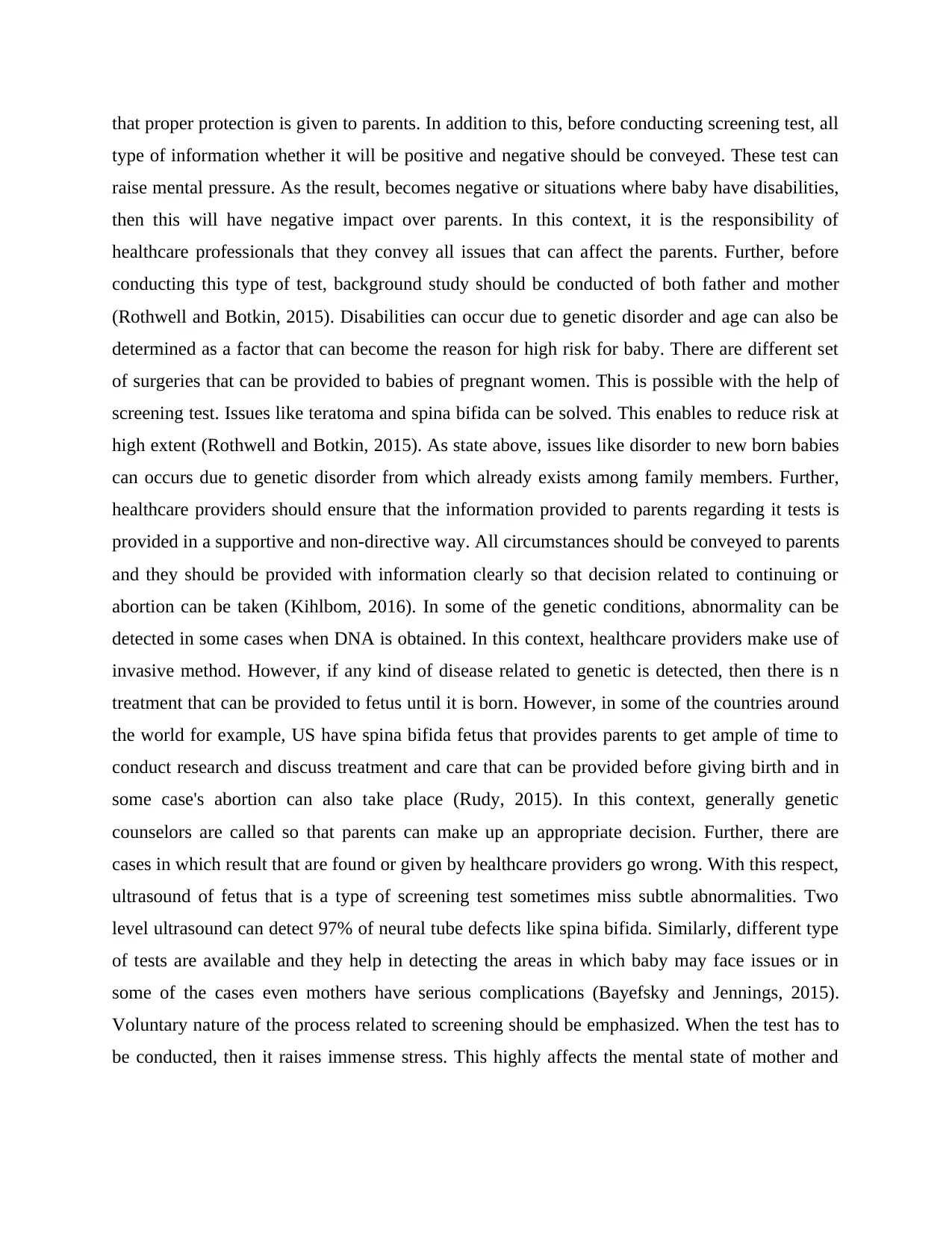
that proper protection is given to parents. In addition to this, before conducting screening test, all
type of information whether it will be positive and negative should be conveyed. These test can
raise mental pressure. As the result, becomes negative or situations where baby have disabilities,
then this will have negative impact over parents. In this context, it is the responsibility of
healthcare professionals that they convey all issues that can affect the parents. Further, before
conducting this type of test, background study should be conducted of both father and mother
(Rothwell and Botkin, 2015). Disabilities can occur due to genetic disorder and age can also be
determined as a factor that can become the reason for high risk for baby. There are different set
of surgeries that can be provided to babies of pregnant women. This is possible with the help of
screening test. Issues like teratoma and spina bifida can be solved. This enables to reduce risk at
high extent (Rothwell and Botkin, 2015). As state above, issues like disorder to new born babies
can occurs due to genetic disorder from which already exists among family members. Further,
healthcare providers should ensure that the information provided to parents regarding it tests is
provided in a supportive and non-directive way. All circumstances should be conveyed to parents
and they should be provided with information clearly so that decision related to continuing or
abortion can be taken (Kihlbom, 2016). In some of the genetic conditions, abnormality can be
detected in some cases when DNA is obtained. In this context, healthcare providers make use of
invasive method. However, if any kind of disease related to genetic is detected, then there is n
treatment that can be provided to fetus until it is born. However, in some of the countries around
the world for example, US have spina bifida fetus that provides parents to get ample of time to
conduct research and discuss treatment and care that can be provided before giving birth and in
some case's abortion can also take place (Rudy, 2015). In this context, generally genetic
counselors are called so that parents can make up an appropriate decision. Further, there are
cases in which result that are found or given by healthcare providers go wrong. With this respect,
ultrasound of fetus that is a type of screening test sometimes miss subtle abnormalities. Two
level ultrasound can detect 97% of neural tube defects like spina bifida. Similarly, different type
of tests are available and they help in detecting the areas in which baby may face issues or in
some of the cases even mothers have serious complications (Bayefsky and Jennings, 2015).
Voluntary nature of the process related to screening should be emphasized. When the test has to
be conducted, then it raises immense stress. This highly affects the mental state of mother and
type of information whether it will be positive and negative should be conveyed. These test can
raise mental pressure. As the result, becomes negative or situations where baby have disabilities,
then this will have negative impact over parents. In this context, it is the responsibility of
healthcare professionals that they convey all issues that can affect the parents. Further, before
conducting this type of test, background study should be conducted of both father and mother
(Rothwell and Botkin, 2015). Disabilities can occur due to genetic disorder and age can also be
determined as a factor that can become the reason for high risk for baby. There are different set
of surgeries that can be provided to babies of pregnant women. This is possible with the help of
screening test. Issues like teratoma and spina bifida can be solved. This enables to reduce risk at
high extent (Rothwell and Botkin, 2015). As state above, issues like disorder to new born babies
can occurs due to genetic disorder from which already exists among family members. Further,
healthcare providers should ensure that the information provided to parents regarding it tests is
provided in a supportive and non-directive way. All circumstances should be conveyed to parents
and they should be provided with information clearly so that decision related to continuing or
abortion can be taken (Kihlbom, 2016). In some of the genetic conditions, abnormality can be
detected in some cases when DNA is obtained. In this context, healthcare providers make use of
invasive method. However, if any kind of disease related to genetic is detected, then there is n
treatment that can be provided to fetus until it is born. However, in some of the countries around
the world for example, US have spina bifida fetus that provides parents to get ample of time to
conduct research and discuss treatment and care that can be provided before giving birth and in
some case's abortion can also take place (Rudy, 2015). In this context, generally genetic
counselors are called so that parents can make up an appropriate decision. Further, there are
cases in which result that are found or given by healthcare providers go wrong. With this respect,
ultrasound of fetus that is a type of screening test sometimes miss subtle abnormalities. Two
level ultrasound can detect 97% of neural tube defects like spina bifida. Similarly, different type
of tests are available and they help in detecting the areas in which baby may face issues or in
some of the cases even mothers have serious complications (Bayefsky and Jennings, 2015).
Voluntary nature of the process related to screening should be emphasized. When the test has to
be conducted, then it raises immense stress. This highly affects the mental state of mother and
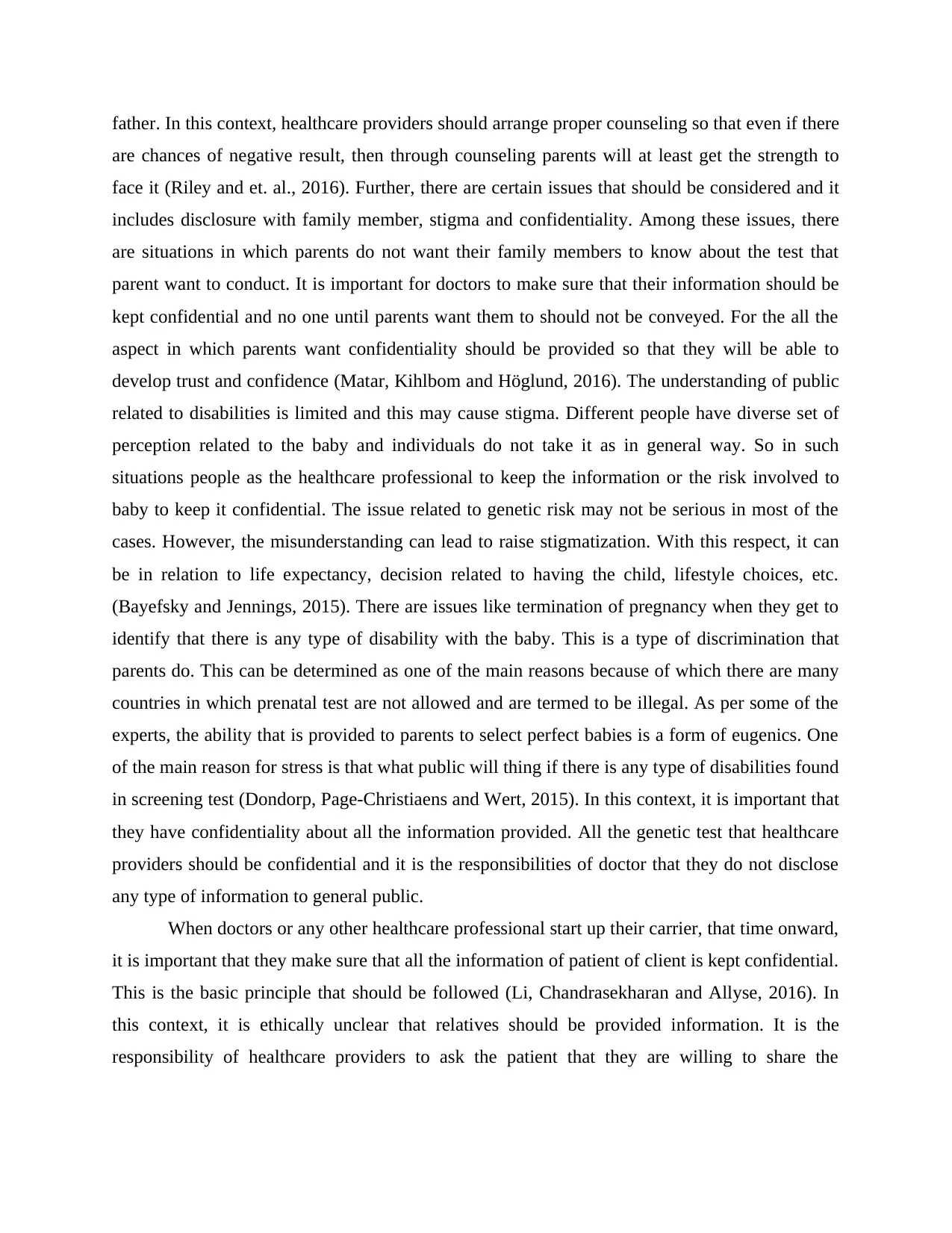
father. In this context, healthcare providers should arrange proper counseling so that even if there
are chances of negative result, then through counseling parents will at least get the strength to
face it (Riley and et. al., 2016). Further, there are certain issues that should be considered and it
includes disclosure with family member, stigma and confidentiality. Among these issues, there
are situations in which parents do not want their family members to know about the test that
parent want to conduct. It is important for doctors to make sure that their information should be
kept confidential and no one until parents want them to should not be conveyed. For the all the
aspect in which parents want confidentiality should be provided so that they will be able to
develop trust and confidence (Matar, Kihlbom and Höglund, 2016). The understanding of public
related to disabilities is limited and this may cause stigma. Different people have diverse set of
perception related to the baby and individuals do not take it as in general way. So in such
situations people as the healthcare professional to keep the information or the risk involved to
baby to keep it confidential. The issue related to genetic risk may not be serious in most of the
cases. However, the misunderstanding can lead to raise stigmatization. With this respect, it can
be in relation to life expectancy, decision related to having the child, lifestyle choices, etc.
(Bayefsky and Jennings, 2015). There are issues like termination of pregnancy when they get to
identify that there is any type of disability with the baby. This is a type of discrimination that
parents do. This can be determined as one of the main reasons because of which there are many
countries in which prenatal test are not allowed and are termed to be illegal. As per some of the
experts, the ability that is provided to parents to select perfect babies is a form of eugenics. One
of the main reason for stress is that what public will thing if there is any type of disabilities found
in screening test (Dondorp, Page‐Christiaens and Wert, 2015). In this context, it is important that
they have confidentiality about all the information provided. All the genetic test that healthcare
providers should be confidential and it is the responsibilities of doctor that they do not disclose
any type of information to general public.
When doctors or any other healthcare professional start up their carrier, that time onward,
it is important that they make sure that all the information of patient of client is kept confidential.
This is the basic principle that should be followed (Li, Chandrasekharan and Allyse, 2016). In
this context, it is ethically unclear that relatives should be provided information. It is the
responsibility of healthcare providers to ask the patient that they are willing to share the
are chances of negative result, then through counseling parents will at least get the strength to
face it (Riley and et. al., 2016). Further, there are certain issues that should be considered and it
includes disclosure with family member, stigma and confidentiality. Among these issues, there
are situations in which parents do not want their family members to know about the test that
parent want to conduct. It is important for doctors to make sure that their information should be
kept confidential and no one until parents want them to should not be conveyed. For the all the
aspect in which parents want confidentiality should be provided so that they will be able to
develop trust and confidence (Matar, Kihlbom and Höglund, 2016). The understanding of public
related to disabilities is limited and this may cause stigma. Different people have diverse set of
perception related to the baby and individuals do not take it as in general way. So in such
situations people as the healthcare professional to keep the information or the risk involved to
baby to keep it confidential. The issue related to genetic risk may not be serious in most of the
cases. However, the misunderstanding can lead to raise stigmatization. With this respect, it can
be in relation to life expectancy, decision related to having the child, lifestyle choices, etc.
(Bayefsky and Jennings, 2015). There are issues like termination of pregnancy when they get to
identify that there is any type of disability with the baby. This is a type of discrimination that
parents do. This can be determined as one of the main reasons because of which there are many
countries in which prenatal test are not allowed and are termed to be illegal. As per some of the
experts, the ability that is provided to parents to select perfect babies is a form of eugenics. One
of the main reason for stress is that what public will thing if there is any type of disabilities found
in screening test (Dondorp, Page‐Christiaens and Wert, 2015). In this context, it is important that
they have confidentiality about all the information provided. All the genetic test that healthcare
providers should be confidential and it is the responsibilities of doctor that they do not disclose
any type of information to general public.
When doctors or any other healthcare professional start up their carrier, that time onward,
it is important that they make sure that all the information of patient of client is kept confidential.
This is the basic principle that should be followed (Li, Chandrasekharan and Allyse, 2016). In
this context, it is ethically unclear that relatives should be provided information. It is the
responsibility of healthcare providers to ask the patient that they are willing to share the
Paraphrase This Document
Need a fresh take? Get an instant paraphrase of this document with our AI Paraphraser
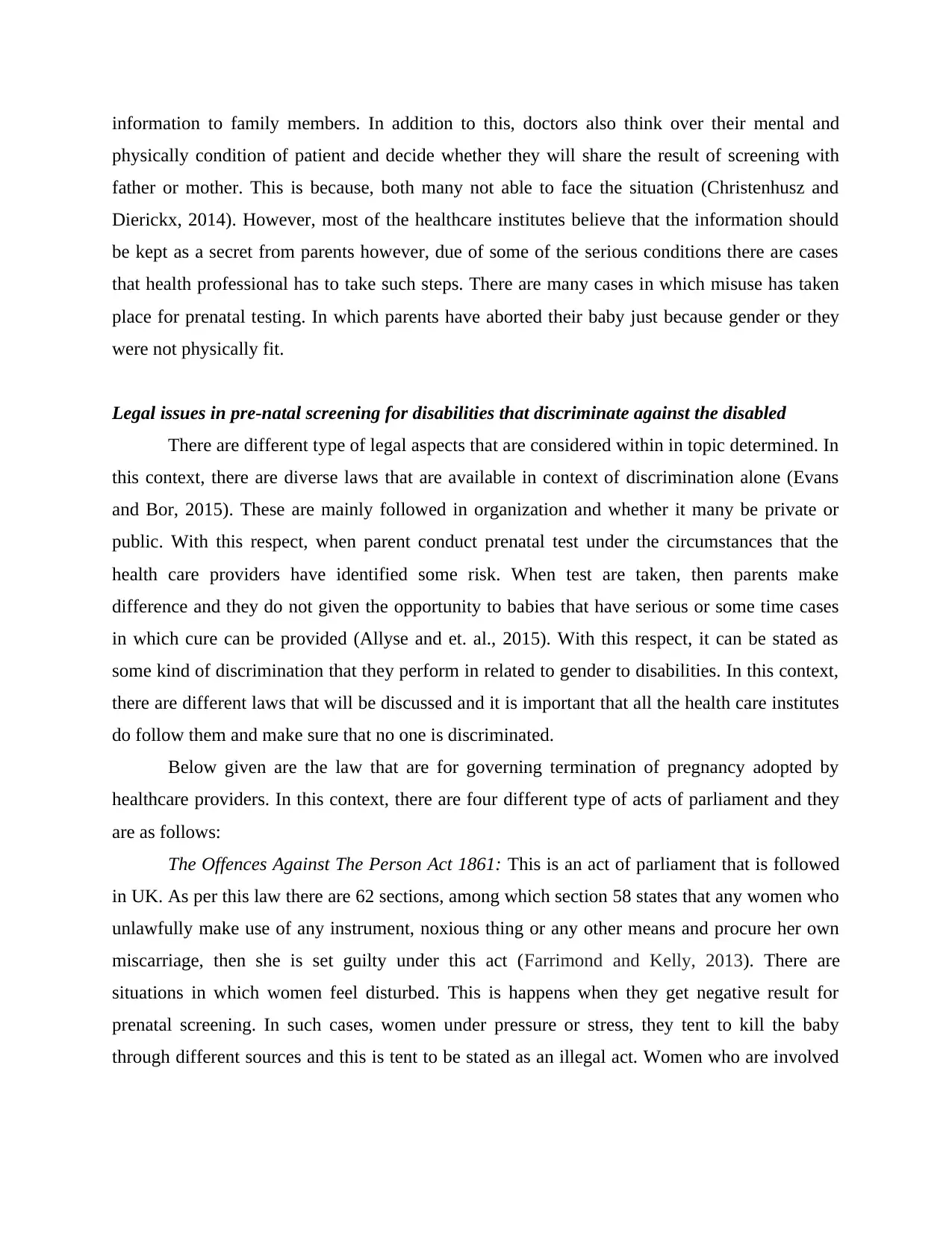
information to family members. In addition to this, doctors also think over their mental and
physically condition of patient and decide whether they will share the result of screening with
father or mother. This is because, both many not able to face the situation (Christenhusz and
Dierickx, 2014). However, most of the healthcare institutes believe that the information should
be kept as a secret from parents however, due of some of the serious conditions there are cases
that health professional has to take such steps. There are many cases in which misuse has taken
place for prenatal testing. In which parents have aborted their baby just because gender or they
were not physically fit.
Legal issues in pre-natal screening for disabilities that discriminate against the disabled
There are different type of legal aspects that are considered within in topic determined. In
this context, there are diverse laws that are available in context of discrimination alone (Evans
and Bor, 2015). These are mainly followed in organization and whether it many be private or
public. With this respect, when parent conduct prenatal test under the circumstances that the
health care providers have identified some risk. When test are taken, then parents make
difference and they do not given the opportunity to babies that have serious or some time cases
in which cure can be provided (Allyse and et. al., 2015). With this respect, it can be stated as
some kind of discrimination that they perform in related to gender to disabilities. In this context,
there are different laws that will be discussed and it is important that all the health care institutes
do follow them and make sure that no one is discriminated.
Below given are the law that are for governing termination of pregnancy adopted by
healthcare providers. In this context, there are four different type of acts of parliament and they
are as follows:
The Offences Against The Person Act 1861: This is an act of parliament that is followed
in UK. As per this law there are 62 sections, among which section 58 states that any women who
unlawfully make use of any instrument, noxious thing or any other means and procure her own
miscarriage, then she is set guilty under this act (Farrimond and Kelly, 2013). There are
situations in which women feel disturbed. This is happens when they get negative result for
prenatal screening. In such cases, women under pressure or stress, they tent to kill the baby
through different sources and this is tent to be stated as an illegal act. Women who are involved
physically condition of patient and decide whether they will share the result of screening with
father or mother. This is because, both many not able to face the situation (Christenhusz and
Dierickx, 2014). However, most of the healthcare institutes believe that the information should
be kept as a secret from parents however, due of some of the serious conditions there are cases
that health professional has to take such steps. There are many cases in which misuse has taken
place for prenatal testing. In which parents have aborted their baby just because gender or they
were not physically fit.
Legal issues in pre-natal screening for disabilities that discriminate against the disabled
There are different type of legal aspects that are considered within in topic determined. In
this context, there are diverse laws that are available in context of discrimination alone (Evans
and Bor, 2015). These are mainly followed in organization and whether it many be private or
public. With this respect, when parent conduct prenatal test under the circumstances that the
health care providers have identified some risk. When test are taken, then parents make
difference and they do not given the opportunity to babies that have serious or some time cases
in which cure can be provided (Allyse and et. al., 2015). With this respect, it can be stated as
some kind of discrimination that they perform in related to gender to disabilities. In this context,
there are different laws that will be discussed and it is important that all the health care institutes
do follow them and make sure that no one is discriminated.
Below given are the law that are for governing termination of pregnancy adopted by
healthcare providers. In this context, there are four different type of acts of parliament and they
are as follows:
The Offences Against The Person Act 1861: This is an act of parliament that is followed
in UK. As per this law there are 62 sections, among which section 58 states that any women who
unlawfully make use of any instrument, noxious thing or any other means and procure her own
miscarriage, then she is set guilty under this act (Farrimond and Kelly, 2013). There are
situations in which women feel disturbed. This is happens when they get negative result for
prenatal screening. In such cases, women under pressure or stress, they tent to kill the baby
through different sources and this is tent to be stated as an illegal act. Women who are involved
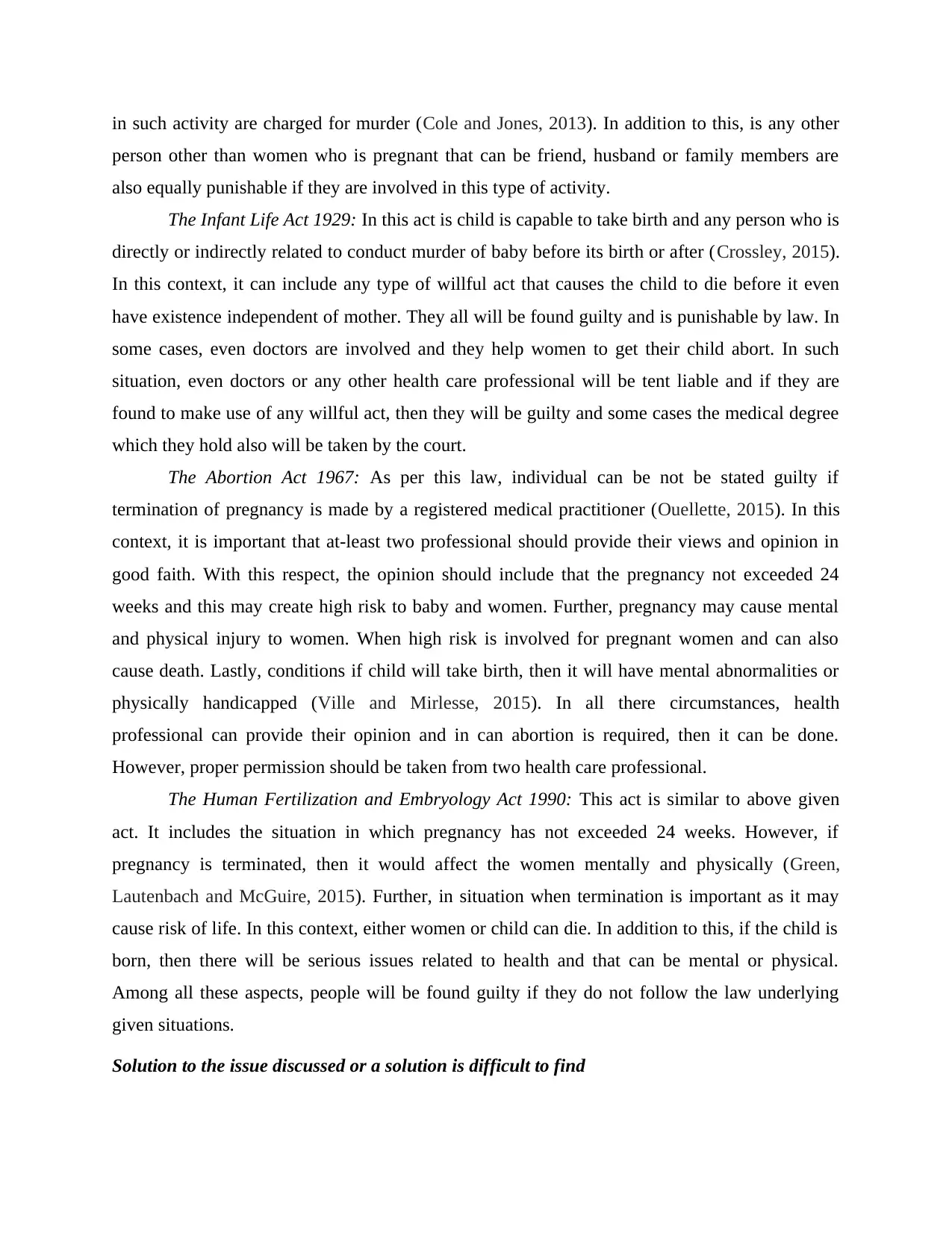
in such activity are charged for murder (Cole and Jones, 2013). In addition to this, is any other
person other than women who is pregnant that can be friend, husband or family members are
also equally punishable if they are involved in this type of activity.
The Infant Life Act 1929: In this act is child is capable to take birth and any person who is
directly or indirectly related to conduct murder of baby before its birth or after (Crossley, 2015).
In this context, it can include any type of willful act that causes the child to die before it even
have existence independent of mother. They all will be found guilty and is punishable by law. In
some cases, even doctors are involved and they help women to get their child abort. In such
situation, even doctors or any other health care professional will be tent liable and if they are
found to make use of any willful act, then they will be guilty and some cases the medical degree
which they hold also will be taken by the court.
The Abortion Act 1967: As per this law, individual can be not be stated guilty if
termination of pregnancy is made by a registered medical practitioner (Ouellette, 2015). In this
context, it is important that at-least two professional should provide their views and opinion in
good faith. With this respect, the opinion should include that the pregnancy not exceeded 24
weeks and this may create high risk to baby and women. Further, pregnancy may cause mental
and physical injury to women. When high risk is involved for pregnant women and can also
cause death. Lastly, conditions if child will take birth, then it will have mental abnormalities or
physically handicapped (Ville and Mirlesse, 2015). In all there circumstances, health
professional can provide their opinion and in can abortion is required, then it can be done.
However, proper permission should be taken from two health care professional.
The Human Fertilization and Embryology Act 1990: This act is similar to above given
act. It includes the situation in which pregnancy has not exceeded 24 weeks. However, if
pregnancy is terminated, then it would affect the women mentally and physically (Green,
Lautenbach and McGuire, 2015). Further, in situation when termination is important as it may
cause risk of life. In this context, either women or child can die. In addition to this, if the child is
born, then there will be serious issues related to health and that can be mental or physical.
Among all these aspects, people will be found guilty if they do not follow the law underlying
given situations.
Solution to the issue discussed or a solution is difficult to find
person other than women who is pregnant that can be friend, husband or family members are
also equally punishable if they are involved in this type of activity.
The Infant Life Act 1929: In this act is child is capable to take birth and any person who is
directly or indirectly related to conduct murder of baby before its birth or after (Crossley, 2015).
In this context, it can include any type of willful act that causes the child to die before it even
have existence independent of mother. They all will be found guilty and is punishable by law. In
some cases, even doctors are involved and they help women to get their child abort. In such
situation, even doctors or any other health care professional will be tent liable and if they are
found to make use of any willful act, then they will be guilty and some cases the medical degree
which they hold also will be taken by the court.
The Abortion Act 1967: As per this law, individual can be not be stated guilty if
termination of pregnancy is made by a registered medical practitioner (Ouellette, 2015). In this
context, it is important that at-least two professional should provide their views and opinion in
good faith. With this respect, the opinion should include that the pregnancy not exceeded 24
weeks and this may create high risk to baby and women. Further, pregnancy may cause mental
and physical injury to women. When high risk is involved for pregnant women and can also
cause death. Lastly, conditions if child will take birth, then it will have mental abnormalities or
physically handicapped (Ville and Mirlesse, 2015). In all there circumstances, health
professional can provide their opinion and in can abortion is required, then it can be done.
However, proper permission should be taken from two health care professional.
The Human Fertilization and Embryology Act 1990: This act is similar to above given
act. It includes the situation in which pregnancy has not exceeded 24 weeks. However, if
pregnancy is terminated, then it would affect the women mentally and physically (Green,
Lautenbach and McGuire, 2015). Further, in situation when termination is important as it may
cause risk of life. In this context, either women or child can die. In addition to this, if the child is
born, then there will be serious issues related to health and that can be mental or physical.
Among all these aspects, people will be found guilty if they do not follow the law underlying
given situations.
Solution to the issue discussed or a solution is difficult to find
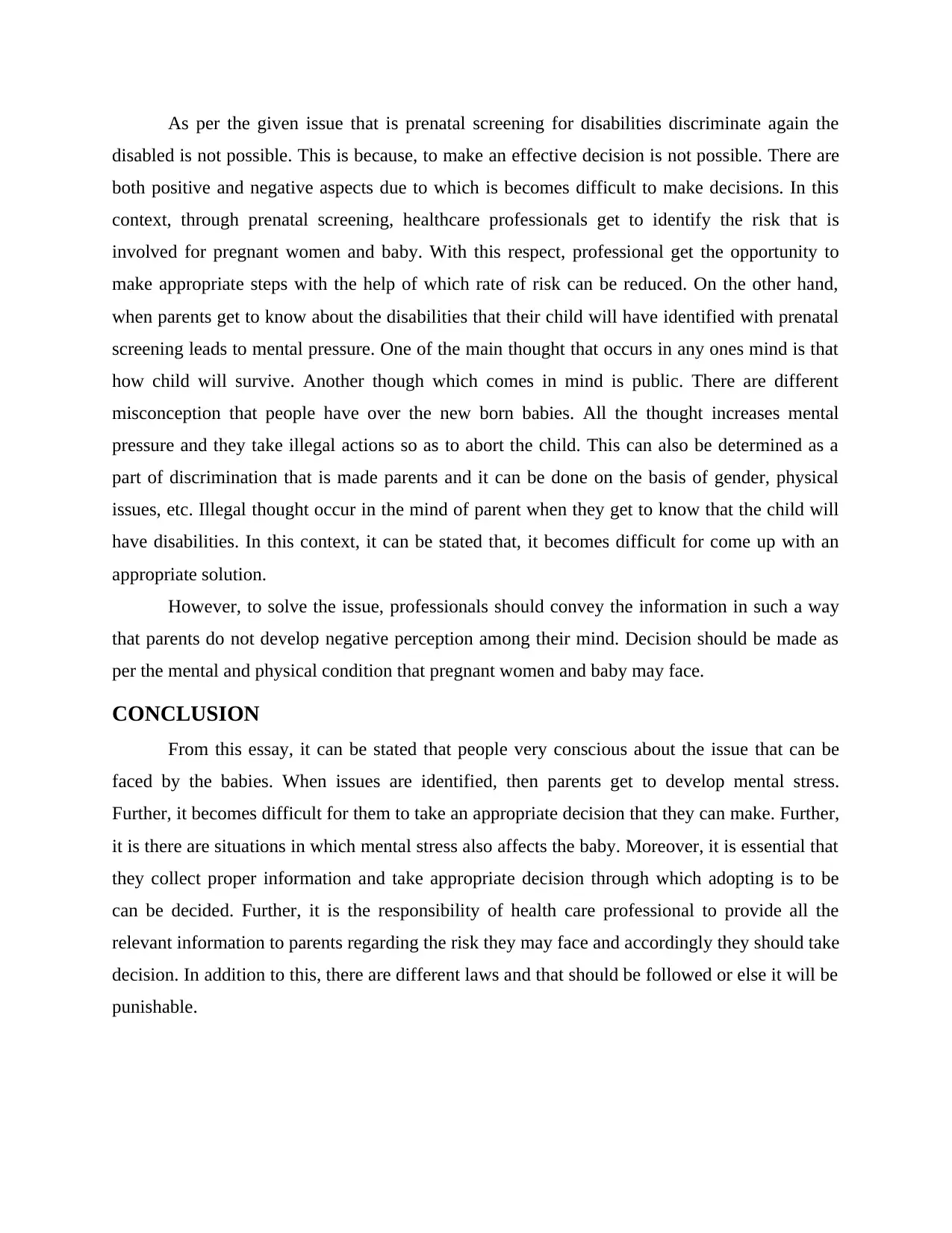
As per the given issue that is prenatal screening for disabilities discriminate again the
disabled is not possible. This is because, to make an effective decision is not possible. There are
both positive and negative aspects due to which is becomes difficult to make decisions. In this
context, through prenatal screening, healthcare professionals get to identify the risk that is
involved for pregnant women and baby. With this respect, professional get the opportunity to
make appropriate steps with the help of which rate of risk can be reduced. On the other hand,
when parents get to know about the disabilities that their child will have identified with prenatal
screening leads to mental pressure. One of the main thought that occurs in any ones mind is that
how child will survive. Another though which comes in mind is public. There are different
misconception that people have over the new born babies. All the thought increases mental
pressure and they take illegal actions so as to abort the child. This can also be determined as a
part of discrimination that is made parents and it can be done on the basis of gender, physical
issues, etc. Illegal thought occur in the mind of parent when they get to know that the child will
have disabilities. In this context, it can be stated that, it becomes difficult for come up with an
appropriate solution.
However, to solve the issue, professionals should convey the information in such a way
that parents do not develop negative perception among their mind. Decision should be made as
per the mental and physical condition that pregnant women and baby may face.
CONCLUSION
From this essay, it can be stated that people very conscious about the issue that can be
faced by the babies. When issues are identified, then parents get to develop mental stress.
Further, it becomes difficult for them to take an appropriate decision that they can make. Further,
it is there are situations in which mental stress also affects the baby. Moreover, it is essential that
they collect proper information and take appropriate decision through which adopting is to be
can be decided. Further, it is the responsibility of health care professional to provide all the
relevant information to parents regarding the risk they may face and accordingly they should take
decision. In addition to this, there are different laws and that should be followed or else it will be
punishable.
disabled is not possible. This is because, to make an effective decision is not possible. There are
both positive and negative aspects due to which is becomes difficult to make decisions. In this
context, through prenatal screening, healthcare professionals get to identify the risk that is
involved for pregnant women and baby. With this respect, professional get the opportunity to
make appropriate steps with the help of which rate of risk can be reduced. On the other hand,
when parents get to know about the disabilities that their child will have identified with prenatal
screening leads to mental pressure. One of the main thought that occurs in any ones mind is that
how child will survive. Another though which comes in mind is public. There are different
misconception that people have over the new born babies. All the thought increases mental
pressure and they take illegal actions so as to abort the child. This can also be determined as a
part of discrimination that is made parents and it can be done on the basis of gender, physical
issues, etc. Illegal thought occur in the mind of parent when they get to know that the child will
have disabilities. In this context, it can be stated that, it becomes difficult for come up with an
appropriate solution.
However, to solve the issue, professionals should convey the information in such a way
that parents do not develop negative perception among their mind. Decision should be made as
per the mental and physical condition that pregnant women and baby may face.
CONCLUSION
From this essay, it can be stated that people very conscious about the issue that can be
faced by the babies. When issues are identified, then parents get to develop mental stress.
Further, it becomes difficult for them to take an appropriate decision that they can make. Further,
it is there are situations in which mental stress also affects the baby. Moreover, it is essential that
they collect proper information and take appropriate decision through which adopting is to be
can be decided. Further, it is the responsibility of health care professional to provide all the
relevant information to parents regarding the risk they may face and accordingly they should take
decision. In addition to this, there are different laws and that should be followed or else it will be
punishable.
Secure Best Marks with AI Grader
Need help grading? Try our AI Grader for instant feedback on your assignments.
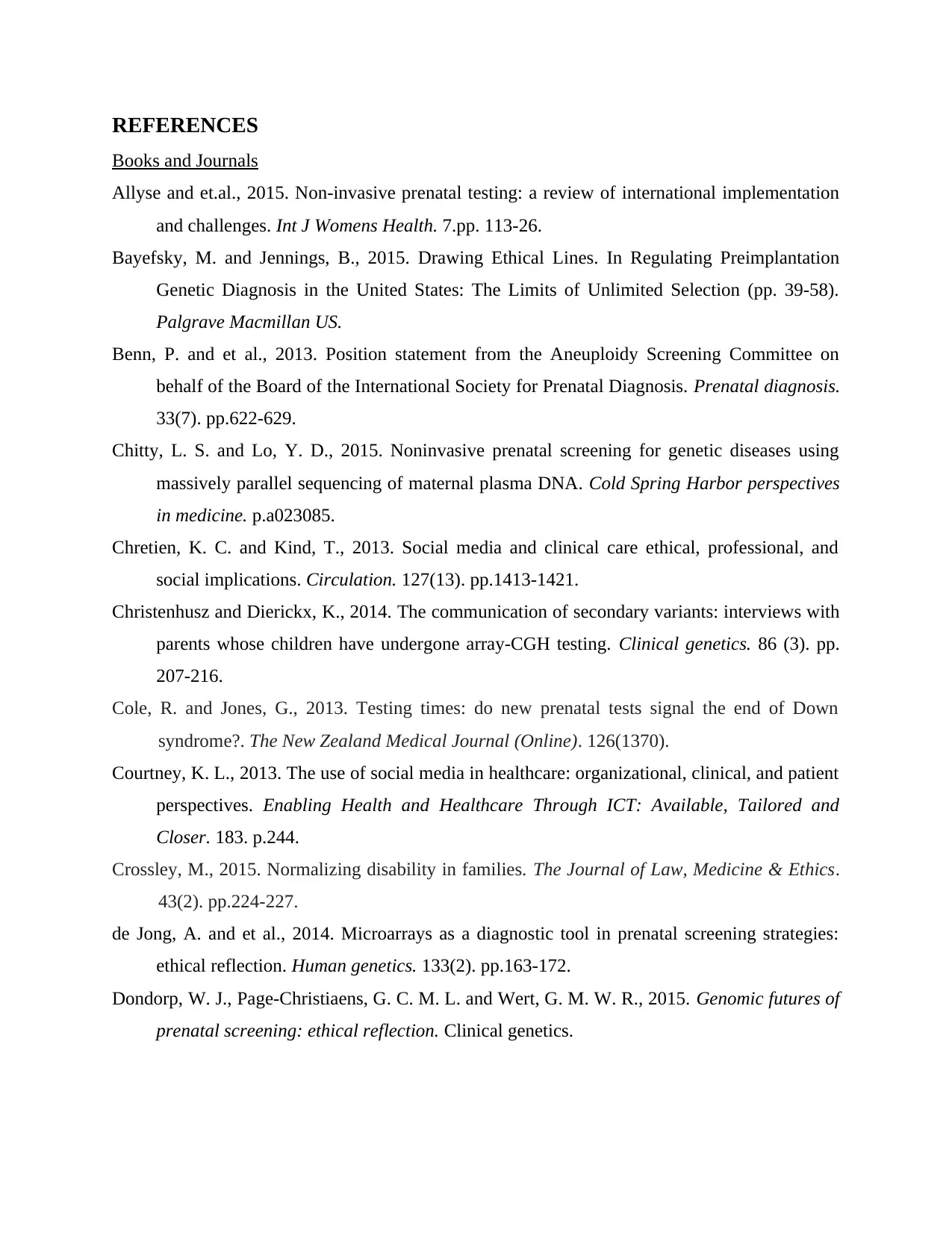
REFERENCES
Books and Journals
Allyse and et.al., 2015. Non-invasive prenatal testing: a review of international implementation
and challenges. Int J Womens Health. 7.pp. 113-26.
Bayefsky, M. and Jennings, B., 2015. Drawing Ethical Lines. In Regulating Preimplantation
Genetic Diagnosis in the United States: The Limits of Unlimited Selection (pp. 39-58).
Palgrave Macmillan US.
Benn, P. and et al., 2013. Position statement from the Aneuploidy Screening Committee on
behalf of the Board of the International Society for Prenatal Diagnosis. Prenatal diagnosis.
33(7). pp.622-629.
Chitty, L. S. and Lo, Y. D., 2015. Noninvasive prenatal screening for genetic diseases using
massively parallel sequencing of maternal plasma DNA. Cold Spring Harbor perspectives
in medicine. p.a023085.
Chretien, K. C. and Kind, T., 2013. Social media and clinical care ethical, professional, and
social implications. Circulation. 127(13). pp.1413-1421.
Christenhusz and Dierickx, K., 2014. The communication of secondary variants: interviews with
parents whose children have undergone array‐CGH testing. Clinical genetics. 86 (3). pp.
207-216.
Cole, R. and Jones, G., 2013. Testing times: do new prenatal tests signal the end of Down
syndrome?. The New Zealand Medical Journal (Online). 126(1370).
Courtney, K. L., 2013. The use of social media in healthcare: organizational, clinical, and patient
perspectives. Enabling Health and Healthcare Through ICT: Available, Tailored and
Closer. 183. p.244.
Crossley, M., 2015. Normalizing disability in families. The Journal of Law, Medicine & Ethics.
43(2). pp.224-227.
de Jong, A. and et al., 2014. Microarrays as a diagnostic tool in prenatal screening strategies:
ethical reflection. Human genetics. 133(2). pp.163-172.
Dondorp, W. J., Page‐Christiaens, G. C. M. L. and Wert, G. M. W. R., 2015. Genomic futures of
prenatal screening: ethical reflection. Clinical genetics.
Books and Journals
Allyse and et.al., 2015. Non-invasive prenatal testing: a review of international implementation
and challenges. Int J Womens Health. 7.pp. 113-26.
Bayefsky, M. and Jennings, B., 2015. Drawing Ethical Lines. In Regulating Preimplantation
Genetic Diagnosis in the United States: The Limits of Unlimited Selection (pp. 39-58).
Palgrave Macmillan US.
Benn, P. and et al., 2013. Position statement from the Aneuploidy Screening Committee on
behalf of the Board of the International Society for Prenatal Diagnosis. Prenatal diagnosis.
33(7). pp.622-629.
Chitty, L. S. and Lo, Y. D., 2015. Noninvasive prenatal screening for genetic diseases using
massively parallel sequencing of maternal plasma DNA. Cold Spring Harbor perspectives
in medicine. p.a023085.
Chretien, K. C. and Kind, T., 2013. Social media and clinical care ethical, professional, and
social implications. Circulation. 127(13). pp.1413-1421.
Christenhusz and Dierickx, K., 2014. The communication of secondary variants: interviews with
parents whose children have undergone array‐CGH testing. Clinical genetics. 86 (3). pp.
207-216.
Cole, R. and Jones, G., 2013. Testing times: do new prenatal tests signal the end of Down
syndrome?. The New Zealand Medical Journal (Online). 126(1370).
Courtney, K. L., 2013. The use of social media in healthcare: organizational, clinical, and patient
perspectives. Enabling Health and Healthcare Through ICT: Available, Tailored and
Closer. 183. p.244.
Crossley, M., 2015. Normalizing disability in families. The Journal of Law, Medicine & Ethics.
43(2). pp.224-227.
de Jong, A. and et al., 2014. Microarrays as a diagnostic tool in prenatal screening strategies:
ethical reflection. Human genetics. 133(2). pp.163-172.
Dondorp, W. J., Page‐Christiaens, G. C. M. L. and Wert, G. M. W. R., 2015. Genomic futures of
prenatal screening: ethical reflection. Clinical genetics.
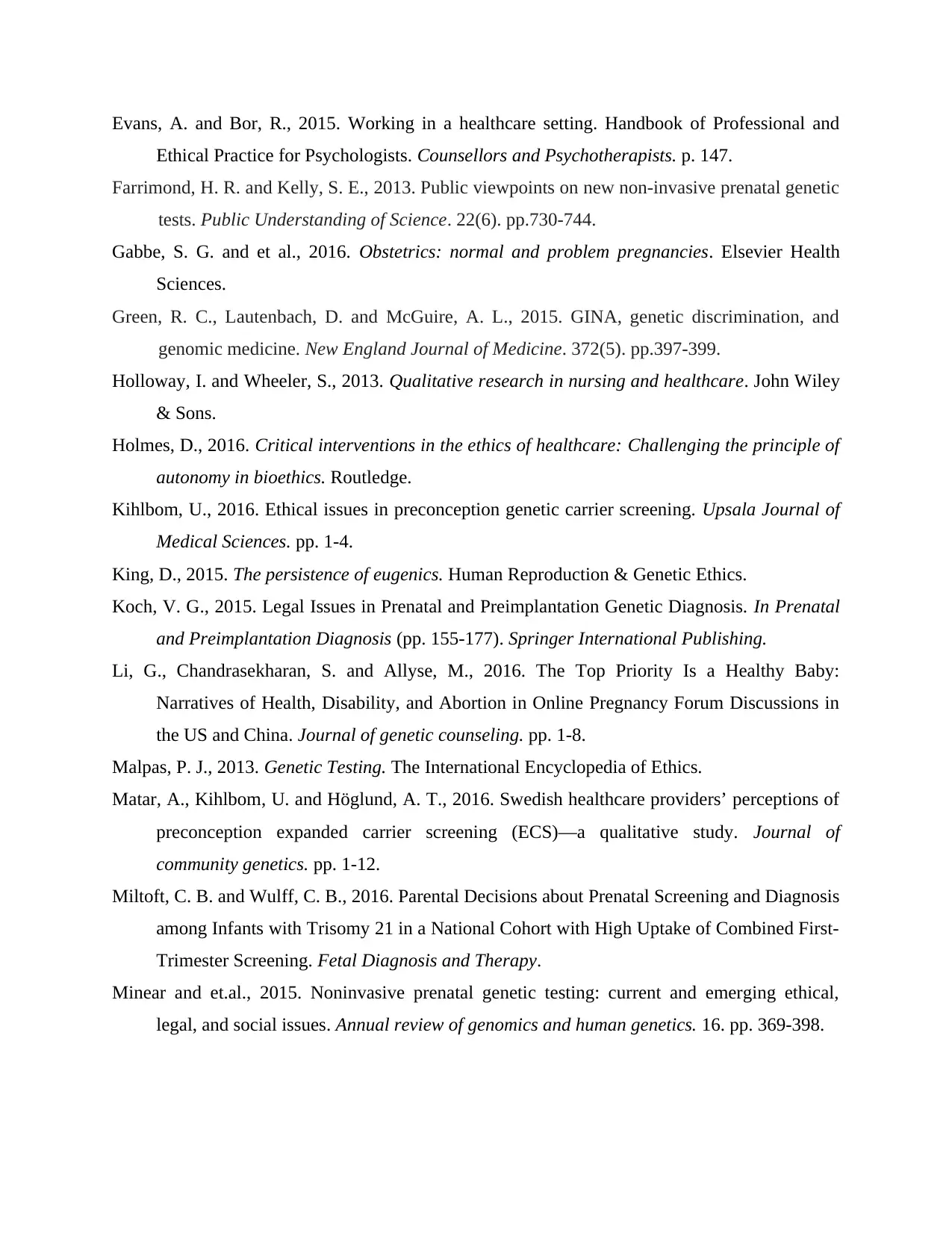
Evans, A. and Bor, R., 2015. Working in a healthcare setting. Handbook of Professional and
Ethical Practice for Psychologists. Counsellors and Psychotherapists. p. 147.
Farrimond, H. R. and Kelly, S. E., 2013. Public viewpoints on new non-invasive prenatal genetic
tests. Public Understanding of Science. 22(6). pp.730-744.
Gabbe, S. G. and et al., 2016. Obstetrics: normal and problem pregnancies. Elsevier Health
Sciences.
Green, R. C., Lautenbach, D. and McGuire, A. L., 2015. GINA, genetic discrimination, and
genomic medicine. New England Journal of Medicine. 372(5). pp.397-399.
Holloway, I. and Wheeler, S., 2013. Qualitative research in nursing and healthcare. John Wiley
& Sons.
Holmes, D., 2016. Critical interventions in the ethics of healthcare: Challenging the principle of
autonomy in bioethics. Routledge.
Kihlbom, U., 2016. Ethical issues in preconception genetic carrier screening. Upsala Journal of
Medical Sciences. pp. 1-4.
King, D., 2015. The persistence of eugenics. Human Reproduction & Genetic Ethics.
Koch, V. G., 2015. Legal Issues in Prenatal and Preimplantation Genetic Diagnosis. In Prenatal
and Preimplantation Diagnosis (pp. 155-177). Springer International Publishing.
Li, G., Chandrasekharan, S. and Allyse, M., 2016. The Top Priority Is a Healthy Baby:
Narratives of Health, Disability, and Abortion in Online Pregnancy Forum Discussions in
the US and China. Journal of genetic counseling. pp. 1-8.
Malpas, P. J., 2013. Genetic Testing. The International Encyclopedia of Ethics.
Matar, A., Kihlbom, U. and Höglund, A. T., 2016. Swedish healthcare providers’ perceptions of
preconception expanded carrier screening (ECS)—a qualitative study. Journal of
community genetics. pp. 1-12.
Miltoft, C. B. and Wulff, C. B., 2016. Parental Decisions about Prenatal Screening and Diagnosis
among Infants with Trisomy 21 in a National Cohort with High Uptake of Combined First-
Trimester Screening. Fetal Diagnosis and Therapy.
Minear and et.al., 2015. Noninvasive prenatal genetic testing: current and emerging ethical,
legal, and social issues. Annual review of genomics and human genetics. 16. pp. 369-398.
Ethical Practice for Psychologists. Counsellors and Psychotherapists. p. 147.
Farrimond, H. R. and Kelly, S. E., 2013. Public viewpoints on new non-invasive prenatal genetic
tests. Public Understanding of Science. 22(6). pp.730-744.
Gabbe, S. G. and et al., 2016. Obstetrics: normal and problem pregnancies. Elsevier Health
Sciences.
Green, R. C., Lautenbach, D. and McGuire, A. L., 2015. GINA, genetic discrimination, and
genomic medicine. New England Journal of Medicine. 372(5). pp.397-399.
Holloway, I. and Wheeler, S., 2013. Qualitative research in nursing and healthcare. John Wiley
& Sons.
Holmes, D., 2016. Critical interventions in the ethics of healthcare: Challenging the principle of
autonomy in bioethics. Routledge.
Kihlbom, U., 2016. Ethical issues in preconception genetic carrier screening. Upsala Journal of
Medical Sciences. pp. 1-4.
King, D., 2015. The persistence of eugenics. Human Reproduction & Genetic Ethics.
Koch, V. G., 2015. Legal Issues in Prenatal and Preimplantation Genetic Diagnosis. In Prenatal
and Preimplantation Diagnosis (pp. 155-177). Springer International Publishing.
Li, G., Chandrasekharan, S. and Allyse, M., 2016. The Top Priority Is a Healthy Baby:
Narratives of Health, Disability, and Abortion in Online Pregnancy Forum Discussions in
the US and China. Journal of genetic counseling. pp. 1-8.
Malpas, P. J., 2013. Genetic Testing. The International Encyclopedia of Ethics.
Matar, A., Kihlbom, U. and Höglund, A. T., 2016. Swedish healthcare providers’ perceptions of
preconception expanded carrier screening (ECS)—a qualitative study. Journal of
community genetics. pp. 1-12.
Miltoft, C. B. and Wulff, C. B., 2016. Parental Decisions about Prenatal Screening and Diagnosis
among Infants with Trisomy 21 in a National Cohort with High Uptake of Combined First-
Trimester Screening. Fetal Diagnosis and Therapy.
Minear and et.al., 2015. Noninvasive prenatal genetic testing: current and emerging ethical,
legal, and social issues. Annual review of genomics and human genetics. 16. pp. 369-398.
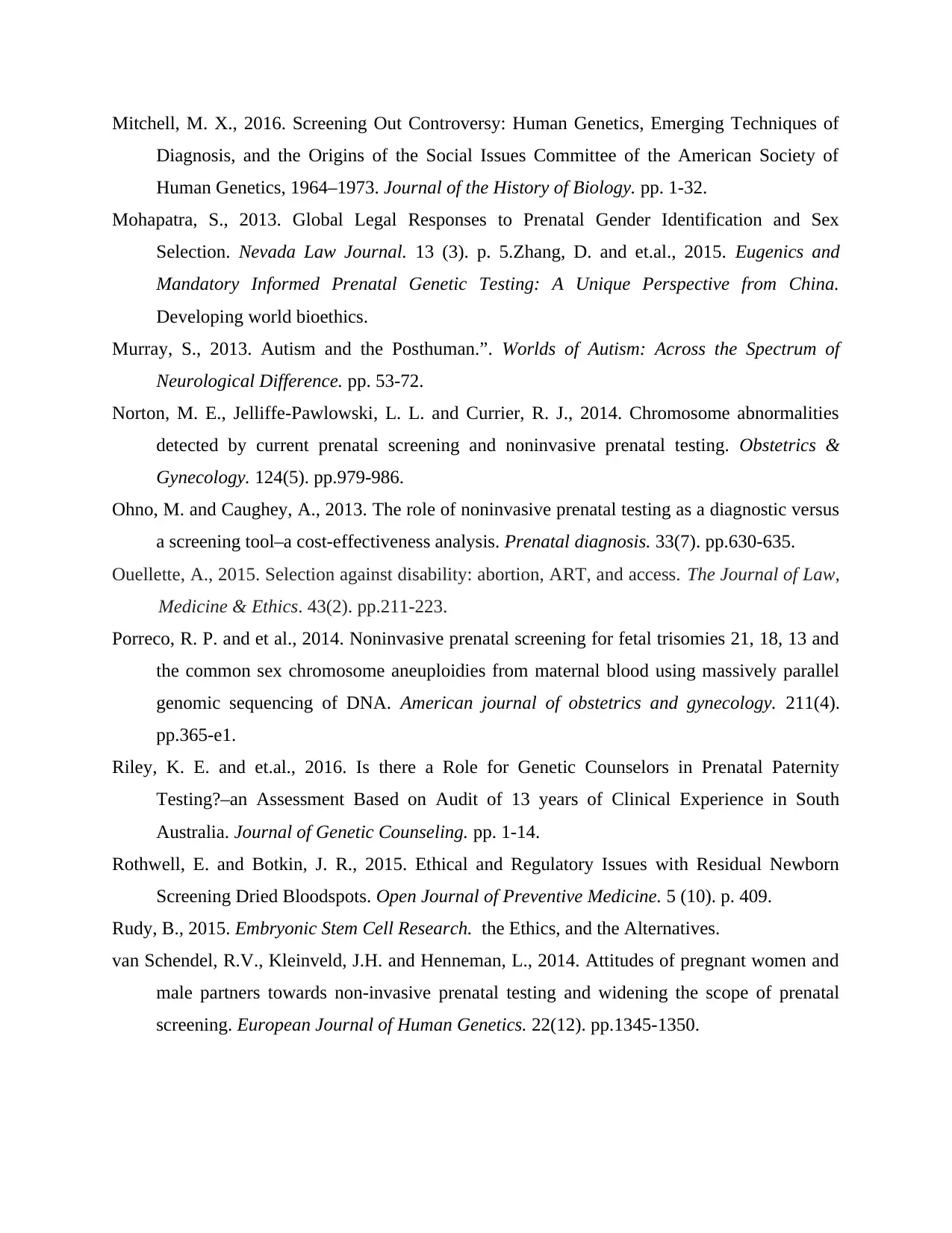
Mitchell, M. X., 2016. Screening Out Controversy: Human Genetics, Emerging Techniques of
Diagnosis, and the Origins of the Social Issues Committee of the American Society of
Human Genetics, 1964–1973. Journal of the History of Biology. pp. 1-32.
Mohapatra, S., 2013. Global Legal Responses to Prenatal Gender Identification and Sex
Selection. Nevada Law Journal. 13 (3). p. 5.Zhang, D. and et.al., 2015. Eugenics and
Mandatory Informed Prenatal Genetic Testing: A Unique Perspective from China.
Developing world bioethics.
Murray, S., 2013. Autism and the Posthuman.”. Worlds of Autism: Across the Spectrum of
Neurological Difference. pp. 53-72.
Norton, M. E., Jelliffe-Pawlowski, L. L. and Currier, R. J., 2014. Chromosome abnormalities
detected by current prenatal screening and noninvasive prenatal testing. Obstetrics &
Gynecology. 124(5). pp.979-986.
Ohno, M. and Caughey, A., 2013. The role of noninvasive prenatal testing as a diagnostic versus
a screening tool–a cost‐effectiveness analysis. Prenatal diagnosis. 33(7). pp.630-635.
Ouellette, A., 2015. Selection against disability: abortion, ART, and access. The Journal of Law,
Medicine & Ethics. 43(2). pp.211-223.
Porreco, R. P. and et al., 2014. Noninvasive prenatal screening for fetal trisomies 21, 18, 13 and
the common sex chromosome aneuploidies from maternal blood using massively parallel
genomic sequencing of DNA. American journal of obstetrics and gynecology. 211(4).
pp.365-e1.
Riley, K. E. and et.al., 2016. Is there a Role for Genetic Counselors in Prenatal Paternity
Testing?–an Assessment Based on Audit of 13 years of Clinical Experience in South
Australia. Journal of Genetic Counseling. pp. 1-14.
Rothwell, E. and Botkin, J. R., 2015. Ethical and Regulatory Issues with Residual Newborn
Screening Dried Bloodspots. Open Journal of Preventive Medicine. 5 (10). p. 409.
Rudy, B., 2015. Embryonic Stem Cell Research. the Ethics, and the Alternatives.
van Schendel, R.V., Kleinveld, J.H. and Henneman, L., 2014. Attitudes of pregnant women and
male partners towards non-invasive prenatal testing and widening the scope of prenatal
screening. European Journal of Human Genetics. 22(12). pp.1345-1350.
Diagnosis, and the Origins of the Social Issues Committee of the American Society of
Human Genetics, 1964–1973. Journal of the History of Biology. pp. 1-32.
Mohapatra, S., 2013. Global Legal Responses to Prenatal Gender Identification and Sex
Selection. Nevada Law Journal. 13 (3). p. 5.Zhang, D. and et.al., 2015. Eugenics and
Mandatory Informed Prenatal Genetic Testing: A Unique Perspective from China.
Developing world bioethics.
Murray, S., 2013. Autism and the Posthuman.”. Worlds of Autism: Across the Spectrum of
Neurological Difference. pp. 53-72.
Norton, M. E., Jelliffe-Pawlowski, L. L. and Currier, R. J., 2014. Chromosome abnormalities
detected by current prenatal screening and noninvasive prenatal testing. Obstetrics &
Gynecology. 124(5). pp.979-986.
Ohno, M. and Caughey, A., 2013. The role of noninvasive prenatal testing as a diagnostic versus
a screening tool–a cost‐effectiveness analysis. Prenatal diagnosis. 33(7). pp.630-635.
Ouellette, A., 2015. Selection against disability: abortion, ART, and access. The Journal of Law,
Medicine & Ethics. 43(2). pp.211-223.
Porreco, R. P. and et al., 2014. Noninvasive prenatal screening for fetal trisomies 21, 18, 13 and
the common sex chromosome aneuploidies from maternal blood using massively parallel
genomic sequencing of DNA. American journal of obstetrics and gynecology. 211(4).
pp.365-e1.
Riley, K. E. and et.al., 2016. Is there a Role for Genetic Counselors in Prenatal Paternity
Testing?–an Assessment Based on Audit of 13 years of Clinical Experience in South
Australia. Journal of Genetic Counseling. pp. 1-14.
Rothwell, E. and Botkin, J. R., 2015. Ethical and Regulatory Issues with Residual Newborn
Screening Dried Bloodspots. Open Journal of Preventive Medicine. 5 (10). p. 409.
Rudy, B., 2015. Embryonic Stem Cell Research. the Ethics, and the Alternatives.
van Schendel, R.V., Kleinveld, J.H. and Henneman, L., 2014. Attitudes of pregnant women and
male partners towards non-invasive prenatal testing and widening the scope of prenatal
screening. European Journal of Human Genetics. 22(12). pp.1345-1350.
Paraphrase This Document
Need a fresh take? Get an instant paraphrase of this document with our AI Paraphraser
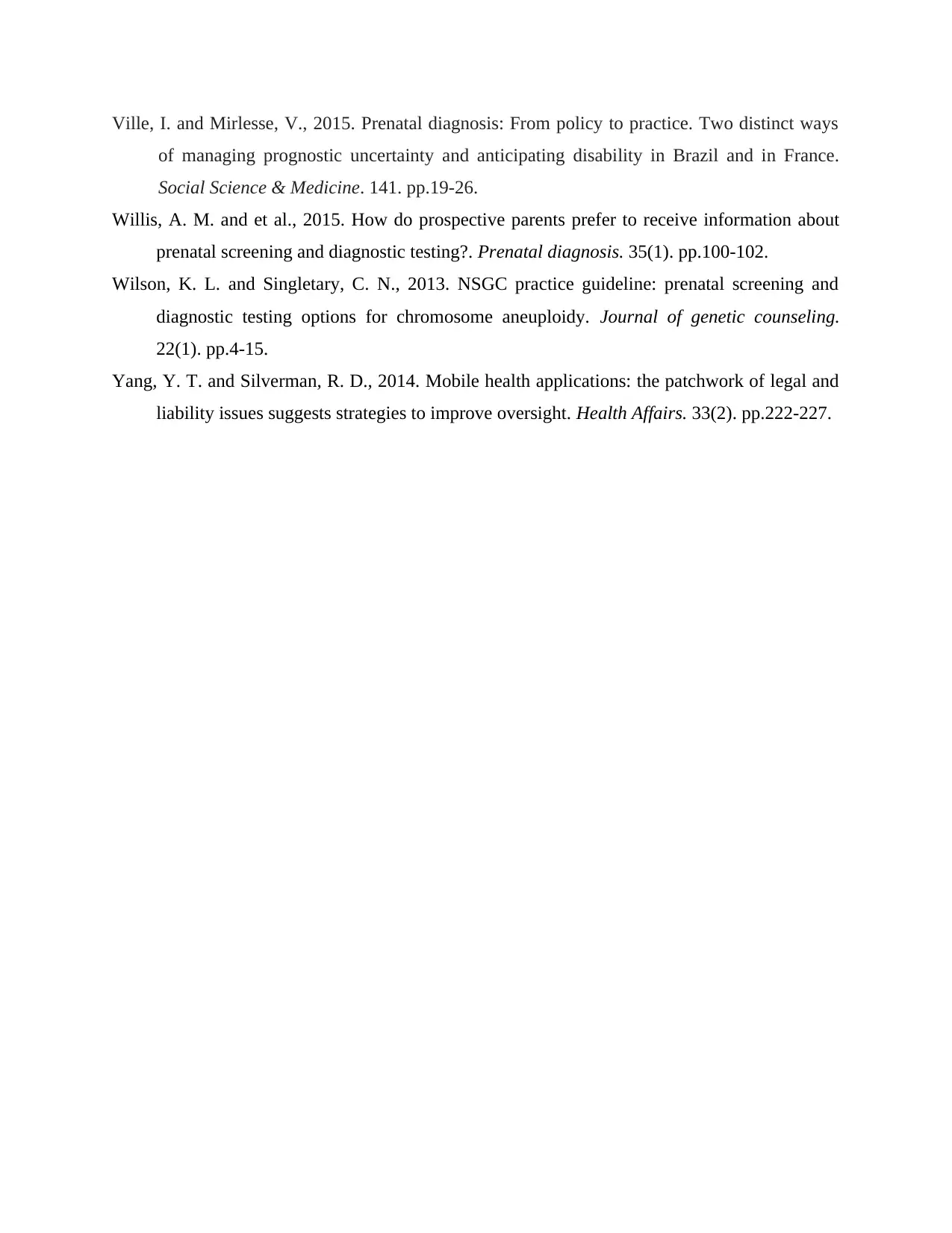
Ville, I. and Mirlesse, V., 2015. Prenatal diagnosis: From policy to practice. Two distinct ways
of managing prognostic uncertainty and anticipating disability in Brazil and in France.
Social Science & Medicine. 141. pp.19-26.
Willis, A. M. and et al., 2015. How do prospective parents prefer to receive information about
prenatal screening and diagnostic testing?. Prenatal diagnosis. 35(1). pp.100-102.
Wilson, K. L. and Singletary, C. N., 2013. NSGC practice guideline: prenatal screening and
diagnostic testing options for chromosome aneuploidy. Journal of genetic counseling.
22(1). pp.4-15.
Yang, Y. T. and Silverman, R. D., 2014. Mobile health applications: the patchwork of legal and
liability issues suggests strategies to improve oversight. Health Affairs. 33(2). pp.222-227.
of managing prognostic uncertainty and anticipating disability in Brazil and in France.
Social Science & Medicine. 141. pp.19-26.
Willis, A. M. and et al., 2015. How do prospective parents prefer to receive information about
prenatal screening and diagnostic testing?. Prenatal diagnosis. 35(1). pp.100-102.
Wilson, K. L. and Singletary, C. N., 2013. NSGC practice guideline: prenatal screening and
diagnostic testing options for chromosome aneuploidy. Journal of genetic counseling.
22(1). pp.4-15.
Yang, Y. T. and Silverman, R. D., 2014. Mobile health applications: the patchwork of legal and
liability issues suggests strategies to improve oversight. Health Affairs. 33(2). pp.222-227.
1 out of 14
Related Documents
Your All-in-One AI-Powered Toolkit for Academic Success.
+13062052269
info@desklib.com
Available 24*7 on WhatsApp / Email
![[object Object]](/_next/static/media/star-bottom.7253800d.svg)
Unlock your academic potential
© 2024 | Zucol Services PVT LTD | All rights reserved.





